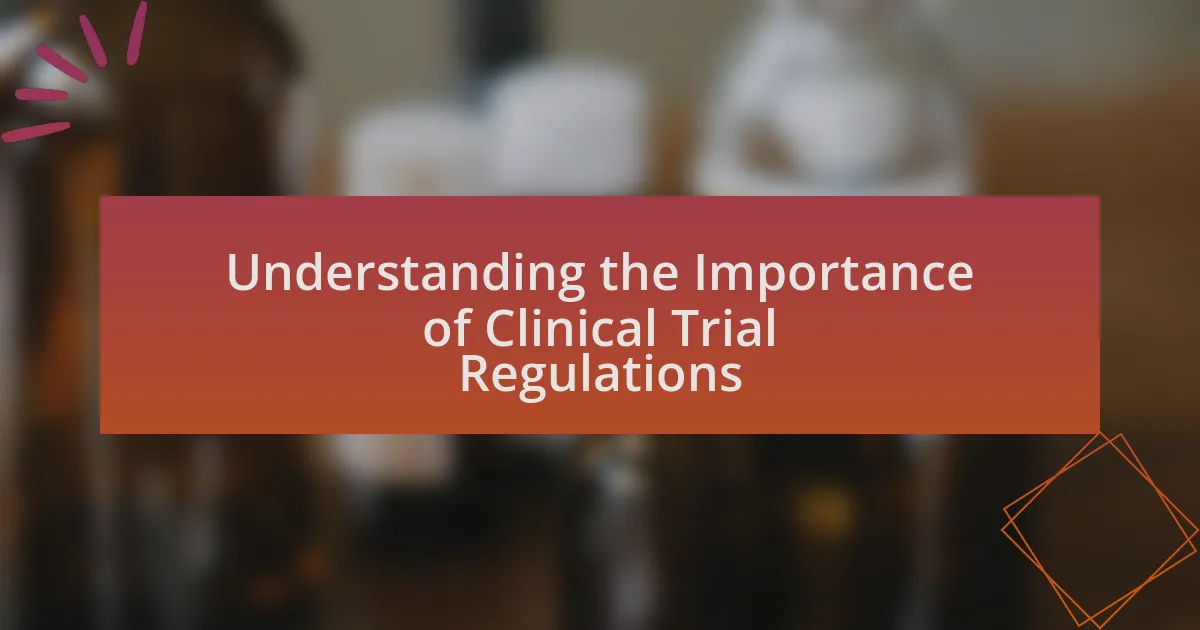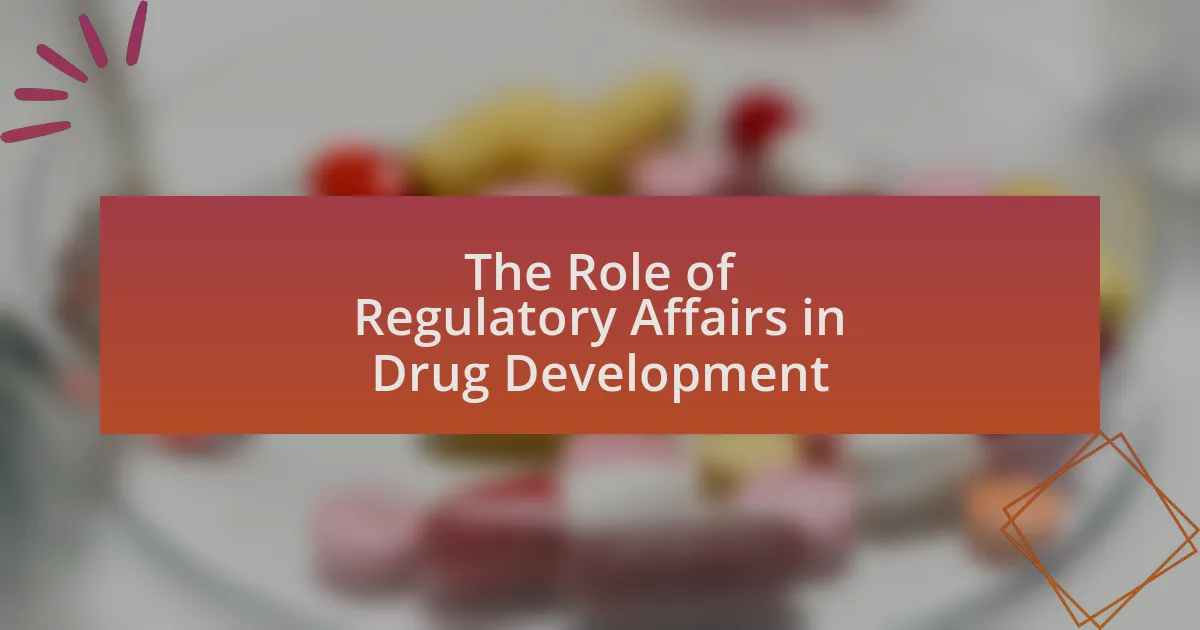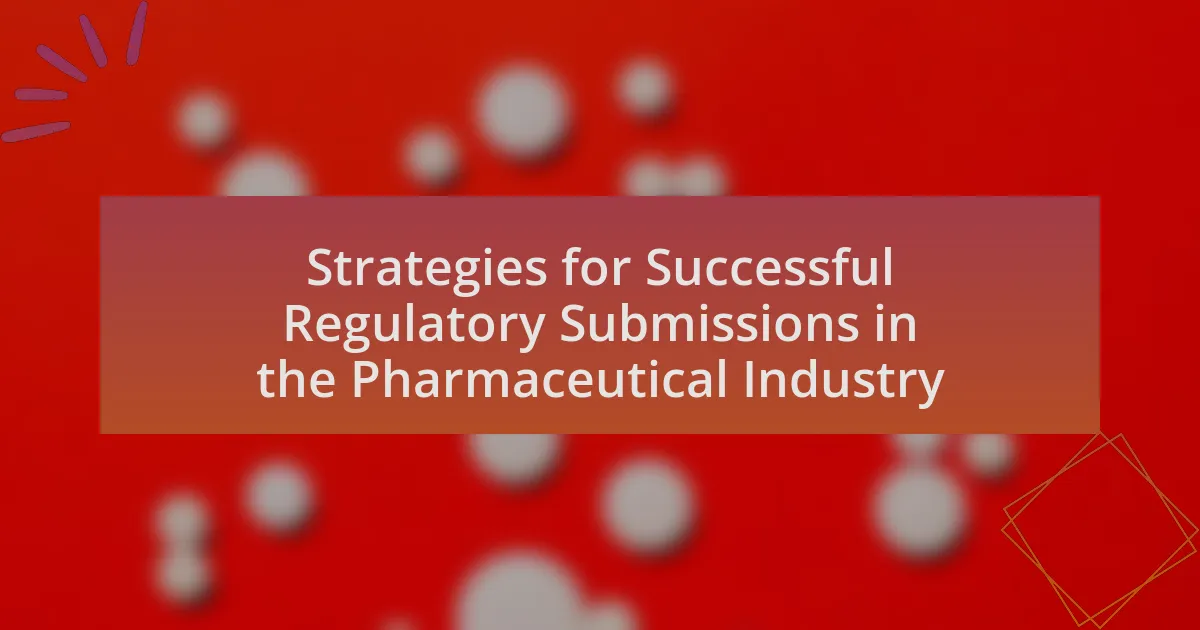The article focuses on the FDA approval process for new pharmaceuticals, detailing the essential stages including preclinical testing, clinical trials, and the submission of a New Drug Application (NDA). It outlines how the FDA defines a new pharmaceutical, the criteria for classification, and the impact of drug classification on the approval process. Key phases of clinical trials are described, along with the importance of ensuring drug safety and efficacy for public health. Additionally, the article addresses challenges faced by pharmaceutical companies, strategies for navigating the approval process, and best practices for preparing successful submissions, emphasizing the role of data management and regulatory compliance.
What is the FDA Approval Process for New Pharmaceuticals?
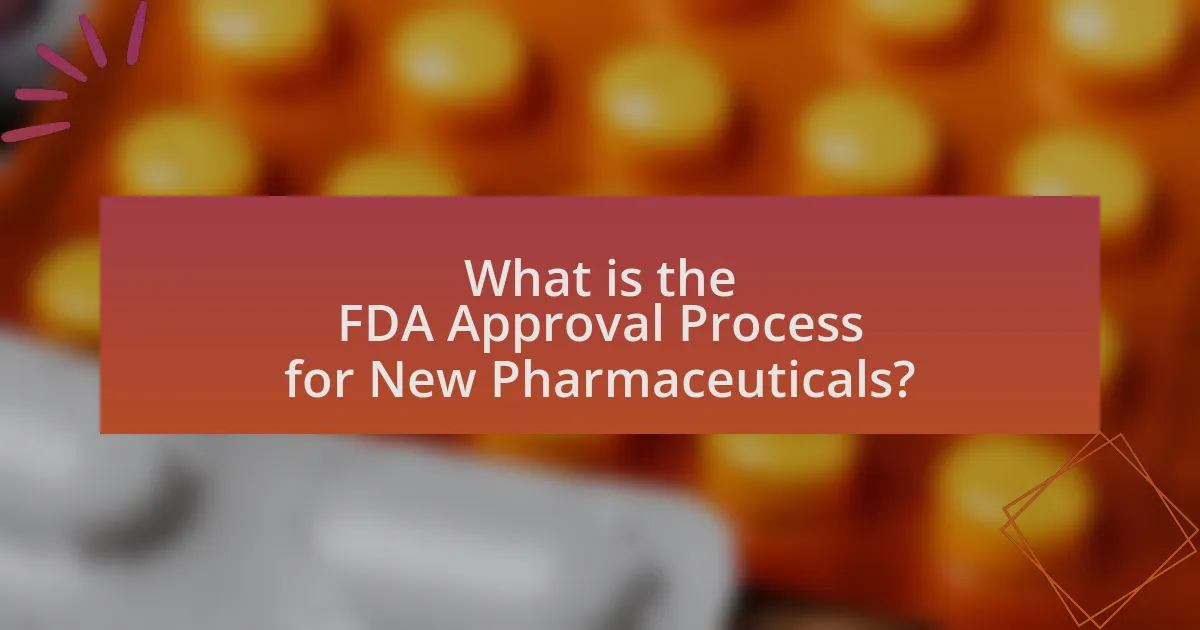
The FDA approval process for new pharmaceuticals involves several key stages: preclinical testing, clinical trials, and review by the FDA. Initially, pharmaceutical companies conduct preclinical testing on laboratory animals to assess safety and efficacy. Following successful preclinical results, companies submit an Investigational New Drug (IND) application to the FDA, which must be approved before clinical trials can begin.
Clinical trials are conducted in three phases: Phase 1 focuses on safety and dosage, Phase 2 evaluates efficacy and side effects, and Phase 3 compares the new drug to standard treatments in larger populations. After completing these trials, companies submit a New Drug Application (NDA) to the FDA. The FDA then reviews the NDA, which includes all data from the trials, and makes a decision on whether to approve the drug for public use.
This process is designed to ensure that new pharmaceuticals are safe and effective before they reach the market, reflecting the FDA’s commitment to public health.
How does the FDA define a new pharmaceutical?
The FDA defines a new pharmaceutical as a drug that has not been previously approved for marketing in the United States. This includes any new chemical entity, new combination of approved drugs, or a new indication for an existing drug. The definition is crucial for the regulatory process, as it determines the requirements for clinical trials and the submission of a New Drug Application (NDA) to demonstrate safety and efficacy before the drug can be marketed.
What criteria must a drug meet to be considered new?
A drug must meet specific criteria to be considered new, including being chemically distinct from existing drugs, demonstrating a novel mechanism of action, or providing a significant improvement in safety or efficacy over current treatments. The U.S. Food and Drug Administration (FDA) defines a new drug as one that has not been previously approved for marketing in the United States. This includes drugs that are new molecular entities, new combinations of existing drugs, or new formulations. The requirement for novelty is crucial, as it ensures that the drug offers unique therapeutic benefits or addresses unmet medical needs, thereby justifying the investment in its development and the regulatory review process.
How does the classification of a drug affect its approval process?
The classification of a drug significantly affects its approval process by determining the regulatory pathway it must follow. Drugs are classified into categories such as prescription, over-the-counter, or controlled substances, which dictate the level of scrutiny and the type of clinical data required for approval. For instance, prescription drugs typically undergo a more rigorous evaluation process, including multiple phases of clinical trials, to assess safety and efficacy, as mandated by the FDA. In contrast, over-the-counter drugs may require less extensive data, often relying on established safety profiles and consumer use data. Additionally, controlled substances face stricter regulations due to their potential for abuse, necessitating more comprehensive documentation and justification for their therapeutic use. This classification system ensures that the approval process aligns with the drug’s risk profile and intended use, ultimately influencing the timeline and requirements for market entry.
What are the key phases of the FDA approval process?
The key phases of the FDA approval process include preclinical testing, clinical trials, and the New Drug Application (NDA) review. Preclinical testing involves laboratory and animal studies to assess safety and biological activity. Clinical trials are conducted in three phases: Phase 1 focuses on safety and dosage, Phase 2 evaluates efficacy and side effects, and Phase 3 confirms effectiveness and monitors adverse reactions in larger populations. After successful trials, the NDA is submitted, where the FDA reviews the data for safety, efficacy, and manufacturing quality before granting approval. This structured process ensures that new pharmaceuticals meet rigorous standards for public health.
What happens during the preclinical phase?
During the preclinical phase, researchers conduct laboratory and animal studies to evaluate the safety and efficacy of a new pharmaceutical compound. This phase involves in vitro (test tube) experiments and in vivo (animal) testing to gather data on pharmacokinetics, pharmacodynamics, and potential toxicity. The results from these studies are crucial for determining whether the compound is suitable for human trials and must be documented in a comprehensive Investigational New Drug (IND) application submitted to the FDA. The preclinical phase is essential for identifying any adverse effects and establishing a preliminary understanding of the drug’s therapeutic potential.
What are the stages of clinical trials?
The stages of clinical trials are typically divided into four phases: Phase I, Phase II, Phase III, and Phase IV. Phase I trials focus on assessing the safety and dosage of a new drug in a small group of healthy volunteers. Phase II trials evaluate the drug’s efficacy and side effects in a larger group of participants who have the condition the drug aims to treat. Phase III trials involve an even larger population to confirm effectiveness, monitor side effects, and compare the drug to commonly used treatments. Finally, Phase IV trials occur after the drug has been approved, focusing on long-term effects and further evaluating its performance in the general population. These structured phases are essential for ensuring the safety and efficacy of new pharmaceuticals before they reach the market.
Why is the FDA approval process important for public health?
The FDA approval process is crucial for public health because it ensures that new pharmaceuticals are safe and effective before they reach consumers. This rigorous evaluation involves multiple phases of clinical trials, which assess the drug’s safety, efficacy, and potential side effects. For instance, the FDA requires that a drug must demonstrate a significant benefit over existing treatments or a favorable risk-benefit profile to gain approval. This process helps prevent harmful or ineffective drugs from entering the market, thereby protecting patients and maintaining trust in the healthcare system.
How does the approval process ensure drug safety and efficacy?
The approval process ensures drug safety and efficacy through rigorous evaluation by regulatory agencies, primarily the FDA. This process involves multiple phases, including preclinical testing, clinical trials, and a comprehensive review of data on the drug’s effects, side effects, and overall performance. During clinical trials, which are conducted in three phases, thousands of participants are monitored to assess the drug’s safety and effectiveness in diverse populations. The FDA requires that the drug demonstrates a favorable risk-benefit profile before it can be approved for public use. Additionally, post-marketing surveillance continues to monitor the drug’s safety once it is on the market, allowing for ongoing assessment and necessary regulatory actions if safety concerns arise. This structured approach, backed by scientific evidence and statistical analysis, ensures that only safe and effective drugs reach consumers.
What role does public trust play in the FDA’s approval process?
Public trust is crucial in the FDA’s approval process as it influences public perception and acceptance of medical products. When the FDA maintains transparency and demonstrates rigorous scientific evaluation, it fosters confidence among the public, which is essential for the successful adoption of new pharmaceuticals. Research indicates that high levels of public trust can lead to increased compliance with medical recommendations and greater willingness to participate in clinical trials, thereby enhancing the overall effectiveness of the approval process.
What challenges do pharmaceutical companies face in the FDA approval process?
Pharmaceutical companies face significant challenges in the FDA approval process, primarily including lengthy review times, high costs, and stringent regulatory requirements. The average time for a new drug application to be reviewed by the FDA is approximately 10 months, which can delay market entry and revenue generation. Additionally, the cost of bringing a new drug to market can exceed $2.6 billion, according to a study published in the Journal of Health Economics. Companies must also navigate complex clinical trial protocols and demonstrate substantial evidence of safety and efficacy, which can lead to further complications and potential rejections. These factors collectively contribute to the difficulties pharmaceutical companies encounter in achieving FDA approval.
How do regulatory hurdles impact drug development timelines?
Regulatory hurdles significantly extend drug development timelines by introducing complex requirements that must be met before a drug can proceed through clinical trials and receive market approval. These hurdles include extensive documentation, safety and efficacy testing, and compliance with Good Manufacturing Practices, which can delay the initiation of trials and the overall approval process. For instance, the average time for a drug to move from discovery to market can take over a decade, with regulatory reviews often accounting for several years of that timeline. According to a study published in the Journal of Health Economics, regulatory delays can add an average of 2.5 years to the development process, highlighting the substantial impact of these hurdles on bringing new pharmaceuticals to market.
What are common reasons for drug application rejections?
Common reasons for drug application rejections include insufficient clinical data, safety concerns, and manufacturing issues. Insufficient clinical data often arises when the submitted studies do not demonstrate the drug’s efficacy or fail to meet the required endpoints. Safety concerns can lead to rejections if adverse effects are significant or not adequately addressed in the application. Manufacturing issues may involve non-compliance with Good Manufacturing Practices (GMP), which can result in the inability to ensure product quality and consistency. These factors are critical in the FDA’s evaluation process, as they directly impact patient safety and treatment effectiveness.
How can pharmaceutical companies effectively navigate the FDA approval process?
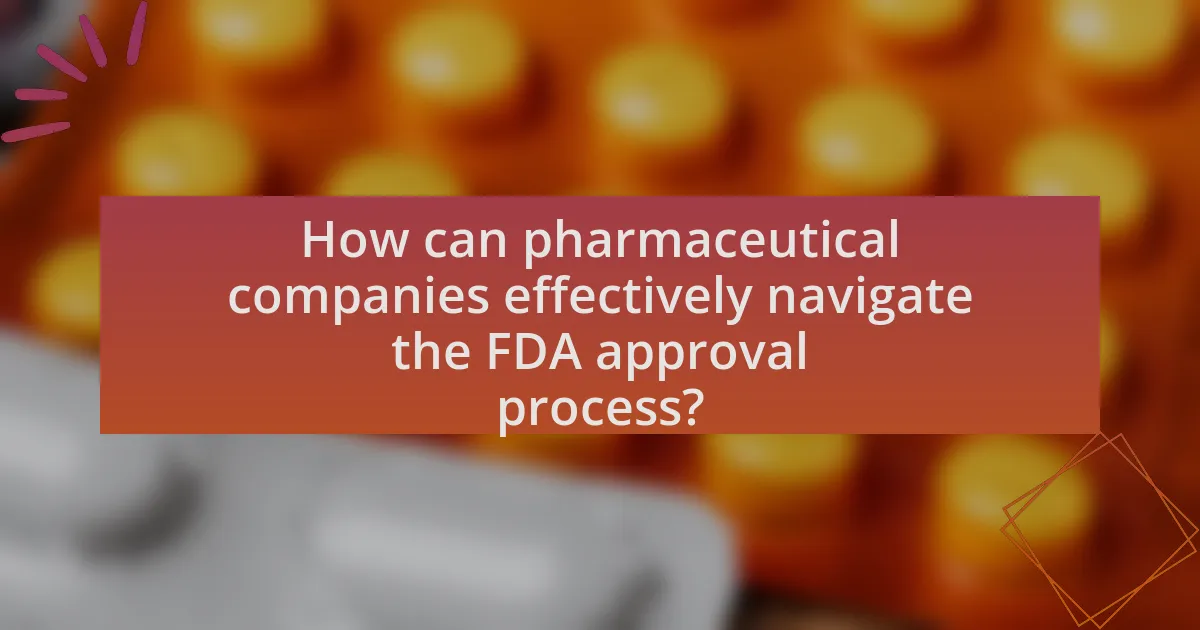
Pharmaceutical companies can effectively navigate the FDA approval process by implementing a strategic approach that includes thorough preclinical research, early engagement with the FDA, and adherence to regulatory guidelines. Conducting comprehensive preclinical studies ensures that the drug demonstrates safety and efficacy before human trials, which is critical for gaining FDA approval. Early engagement with the FDA allows companies to receive guidance on study design and regulatory requirements, reducing the risk of delays. Additionally, following established regulatory guidelines, such as those outlined in the FDA’s guidance documents, helps streamline the submission process and increases the likelihood of a successful application. These strategies are supported by the FDA’s commitment to facilitate the development of safe and effective drugs, as evidenced by initiatives like the Breakthrough Therapy designation, which expedites the review process for promising therapies.
What strategies can be employed to streamline the approval process?
To streamline the approval process for new pharmaceuticals, implementing a collaborative approach between stakeholders is essential. This involves early engagement with the FDA to clarify requirements, utilizing expedited programs such as Fast Track and Breakthrough Therapy designations, and adopting adaptive trial designs that allow for modifications based on interim results. Research indicates that companies employing these strategies can reduce approval timelines significantly; for instance, the FDA’s Fast Track designation can lead to a review period of six months compared to the standard ten months. Additionally, leveraging real-world evidence and patient-centric data can enhance the submission quality, further expediting the review process.
How can early engagement with the FDA benefit drug developers?
Early engagement with the FDA can significantly benefit drug developers by facilitating a clearer understanding of regulatory requirements and expectations. This proactive approach allows developers to identify potential issues early in the drug development process, which can lead to more efficient clinical trial designs and reduced time to market. For instance, the FDA’s guidance documents provide critical insights into the necessary data and study designs required for approval, helping developers align their research with regulatory standards. Additionally, early interactions can foster a collaborative relationship, enabling developers to receive timely feedback that can refine their development strategies and enhance the likelihood of successful approval.
What role does data management play in successful submissions?
Data management is crucial for successful submissions in the FDA approval process for new pharmaceuticals. Effective data management ensures that all clinical trial data is accurately collected, organized, and analyzed, which is essential for demonstrating the safety and efficacy of a new drug. Properly managed data facilitates compliance with regulatory requirements, as it allows for the generation of clear and comprehensive reports that meet FDA standards. Additionally, robust data management practices help identify and rectify discrepancies early in the submission process, reducing the likelihood of delays or rejections.
What resources are available for understanding FDA regulations?
The primary resources available for understanding FDA regulations include the FDA’s official website, which provides comprehensive guidelines, regulatory information, and updates on policies. Additionally, the Code of Federal Regulations (CFR), particularly Title 21, outlines the specific regulations governing food and drugs. The FDA also offers educational materials, webinars, and guidance documents that clarify regulatory processes. Furthermore, professional organizations such as the Regulatory Affairs Professionals Society (RAPS) and the Drug Information Association (DIA) provide training and resources for industry professionals. These resources collectively ensure that stakeholders have access to accurate and up-to-date information regarding FDA regulations.
How can industry associations assist in navigating the approval process?
Industry associations can assist in navigating the approval process by providing resources, guidance, and advocacy for pharmaceutical companies. These associations often offer training programs, workshops, and informational materials that help members understand regulatory requirements and best practices. For example, the Biotechnology Innovation Organization (BIO) provides members with access to regulatory experts and organizes events focused on FDA interactions. Additionally, industry associations advocate on behalf of their members to influence policy and regulatory changes, which can streamline the approval process. This support is crucial as it helps companies stay informed about evolving regulations and fosters collaboration among stakeholders in the pharmaceutical industry.
What online tools and databases can be utilized for research?
Online tools and databases that can be utilized for research include PubMed, ClinicalTrials.gov, and the FDA’s own database. PubMed provides access to a vast repository of biomedical literature, facilitating research on pharmaceuticals and their effects. ClinicalTrials.gov offers detailed information on clinical studies, including their status and results, which is crucial for understanding the FDA approval process. The FDA’s database contains regulatory information, drug approvals, and safety data, essential for navigating the complexities of pharmaceutical development and approval. These resources are widely recognized and utilized by researchers in the field of pharmaceuticals.
What are the best practices for preparing an FDA submission?

The best practices for preparing an FDA submission include thorough documentation, adherence to regulatory guidelines, and early engagement with the FDA. Thorough documentation ensures that all necessary data, including preclinical and clinical trial results, are clearly presented, which is crucial for the review process. Adhering to regulatory guidelines, such as the FDA’s Good Clinical Practice (GCP) and Good Manufacturing Practice (GMP), helps in meeting the agency’s standards and reduces the likelihood of delays. Early engagement with the FDA, through meetings or consultations, allows for clarification of requirements and expectations, which can streamline the submission process. These practices are supported by the FDA’s own recommendations and guidance documents, which emphasize the importance of comprehensive and organized submissions for efficient review.
How should a pharmaceutical company prepare its application?
A pharmaceutical company should prepare its application by thoroughly compiling all necessary data and documentation required for FDA submission. This includes conducting preclinical studies, clinical trials, and gathering comprehensive safety and efficacy data to support the drug’s intended use. The application must also include detailed information on manufacturing processes, labeling, and proposed usage.
To ensure compliance, the company should follow the FDA’s guidelines outlined in the Code of Federal Regulations (CFR), particularly Title 21, which governs food and drugs. Additionally, engaging with the FDA through pre-IND (Investigational New Drug) meetings can provide valuable feedback and help clarify expectations. This proactive approach can significantly enhance the likelihood of a successful application.
What documentation is essential for a successful submission?
The essential documentation for a successful submission in the FDA approval process for new pharmaceuticals includes the Investigational New Drug (IND) application, clinical study protocols, informed consent forms, and the New Drug Application (NDA). The IND application outlines the drug’s composition, manufacturing, and proposed clinical studies, while clinical study protocols detail the methodology for testing the drug’s safety and efficacy. Informed consent forms ensure that participants are fully aware of the study’s risks and benefits. The NDA compiles all data from clinical trials, manufacturing information, and proposed labeling, which is critical for the FDA’s evaluation. These documents collectively provide the necessary evidence for the FDA to assess the drug’s safety and effectiveness, ensuring compliance with regulatory standards.
How can companies ensure compliance with FDA guidelines?
Companies can ensure compliance with FDA guidelines by implementing a robust quality management system that adheres to Good Manufacturing Practices (GMP). This system should include regular training for employees on FDA regulations, thorough documentation of processes, and routine audits to identify and rectify compliance gaps. According to the FDA, adherence to GMP is essential for ensuring that products are consistently produced and controlled according to quality standards, which is critical for maintaining product safety and efficacy.
What common pitfalls should be avoided during the submission process?
Common pitfalls to avoid during the submission process for FDA approval include inadequate documentation, failure to meet regulatory requirements, and poor communication with the FDA. Inadequate documentation can lead to delays or rejections, as the FDA requires comprehensive data to assess safety and efficacy. Failure to meet regulatory requirements, such as not adhering to Good Manufacturing Practices (GMP), can result in non-compliance issues. Additionally, poor communication with the FDA can hinder the submission process; maintaining open lines of dialogue can clarify expectations and reduce misunderstandings. These pitfalls are critical to address, as they can significantly impact the timeline and success of obtaining FDA approval for new pharmaceuticals.
How can inadequate data impact the approval outcome?
Inadequate data can lead to negative approval outcomes by failing to demonstrate the safety and efficacy of a new pharmaceutical. Regulatory bodies, such as the FDA, require comprehensive data to assess whether a drug meets the necessary standards for approval. For instance, incomplete clinical trial results may obscure potential side effects or lack of effectiveness, resulting in a rejection of the application. Historical cases, such as the withdrawal of the painkiller Vioxx, highlight how insufficient data can lead to serious public health consequences and regulatory action.
What are the consequences of miscommunication with the FDA?
Miscommunication with the FDA can lead to significant delays in the approval process for new pharmaceuticals. These delays can result in extended timeframes for bringing essential medications to market, which may adversely affect patient access to treatments. For instance, a study published in the Journal of Pharmaceutical Sciences found that miscommunication can lead to an average delay of 6 to 12 months in the approval timeline, impacting both public health and financial investments in drug development. Furthermore, miscommunication may also result in increased costs for pharmaceutical companies due to the need for additional studies or resubmissions, ultimately affecting the overall viability of new drug candidates.
What practical tips can enhance the chances of FDA approval?
To enhance the chances of FDA approval, it is crucial to conduct thorough preclinical studies and engage in early communication with the FDA. Thorough preclinical studies provide essential data on safety and efficacy, which are critical for the FDA’s evaluation process. Engaging in early communication with the FDA, such as through pre-IND meetings, allows for clarification of regulatory expectations and guidance on study design. According to the FDA’s own guidelines, early interactions can significantly streamline the approval process by addressing potential issues before they arise.
How can building a strong regulatory team improve submission quality?
Building a strong regulatory team enhances submission quality by ensuring comprehensive understanding and adherence to regulatory requirements. A well-structured team possesses diverse expertise, which facilitates thorough preparation and review of submission documents, minimizing errors and omissions. For instance, a study by the Tufts Center for the Study of Drug Development found that companies with dedicated regulatory teams experienced a 30% reduction in submission-related delays. This indicates that a strong regulatory team not only improves the accuracy of submissions but also accelerates the overall approval process, leading to more efficient pathways for new pharmaceuticals to reach the market.
What role does continuous learning play in staying updated with FDA changes?
Continuous learning is essential for professionals in the pharmaceutical industry to stay updated with FDA changes. The FDA frequently updates regulations, guidelines, and policies that impact drug approval processes, and continuous learning enables professionals to adapt to these changes effectively. For instance, the FDA’s introduction of the Drug Approval Modernization Act in 2021 necessitated that industry stakeholders understand new requirements for clinical trials and data submissions. By engaging in ongoing education, attending workshops, and participating in relevant training programs, professionals can ensure compliance and maintain competitive advantage in a rapidly evolving regulatory landscape.



